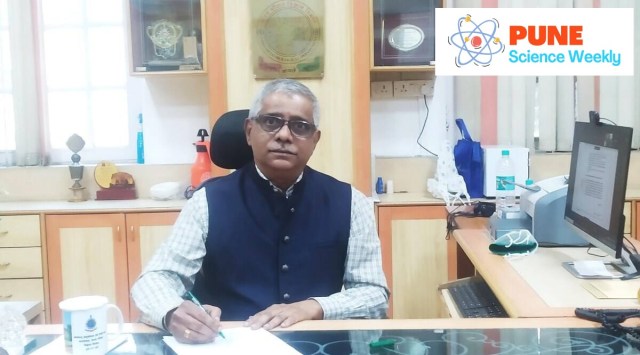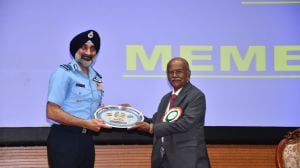Click here to join Express Pune WhatsApp channel and get a curated list of our stories
Pune Science Weekly: ‘Being a meteorologist is a 24×7 job’
On World Meteorological Day, K S Hosalikar, Head of IMD's Climate Research and Services in Pune, speaks to The Indian Express on the challenges of his job and what prepared him for the role.
 K S Hosalikar, Head, Climate Research and Services, IMD, Pune
K S Hosalikar, Head, Climate Research and Services, IMD, PuneMeteorologist Krishnanand Hosalikar’s mind is often occupied thinking of ways and means to relay the latest available weather updates to the desired last-mile user located in remote localities of India.
And, during the three decades of service at the India Meteorological Department (IMD), this has become his life’s mission.
Weather forecasting, Hosalikar says, is one of the most challenging jobs.
Climate change and associated uncertainties are increasing spatially and temporarily alongside their severity. This has further added complexity into weather systems and hence predictions.
Analysing and decoding weather models, scanning satellite and radar images of the IMD even at odd hours of the day, may be just tip of the iceberg.
“I dropped the idea of working 9 am to 5 pm long ago. Being a meteorologist is a 24-hour duty, and it is the requirement of the job,” says Hosalikar, who took charge as the Head, Climate Research and Services (CRS) office of IMD, Pune last month. This was where he had joined as a trainee in 1992.
He has grown to become one of the faces of the IMD, which mostly got brickbats for their forecasts and rainfall predictions until powerful weather models, high performance computing machines, tools and technology came to the rescue in recent years.
Giving tough competition to many government and individual Twitter handles for the information being shared, Hosalikar today has over 19,000 followers on the social media platform. There may be just a few like Hosalikar who have managed to effectively use social media to provide real-time weather information.
“If I am travelling and unable to tweet weather updates at my usual timings, I get phone calls enquiring about the delay. Presenting timely weather information in local languages, that are both user friendly and actionable, is the key. It is not easy,” Hosalikar says.
Coming from a humble background, he credits his training in the National Cadets Corps (NCC) to shaping his early life growing up in Mumbai. Hosalikar started his professional career in 1987 as a lecturer of Physics at KJ Somaiya College of Science and Commerce.
“I had never imagined that I would be a meteorologist someday. Being a teacher of Physics helped my preparation for the Union Public Service Commission exam,” he recalls.
Joining India’s premier Met agency and serving as a weather scientist at many places in the country has been full of learnings, he says.
“I get to interact with different kinds of people – from government officials, disaster managers, farmers, students, media and others. And knowing weather requirements of each stakeholder is vital,” he adds.
“At times, there are criticisms, but they teach me a lot. Whenever I am short of the sought-after information, I go back to the basics and discuss with fellow meteorologists and experts,” he shares.
🗞️ Subscribe Now: Get Express Premium to access the best Election reporting and analysis 🗞️
Being from the instrumentation sciences stream, his first posting was at Delhi’s Palam Airport. Be it the harsh winters in the national capital, travelling to office by hopping onto passing tempos or trucks, or living in areas dominated by Haryanvi-speakers, the job brought new experiences for this Mumbaikar meteorologist.
Later, a year-long stint at the Central Seismological Observatory, Shillong, was far too picturesque with frequent earthquake tremors adding to life’s never-before experiences. Hosalikar shares that he even picked up the basics of Khasi language in order to communicate with the locals.
But, he recalls the mesmerising memory etched till date: “Since the office was located on a hilltop, clouds would enter my office. Initially, they were very scary. In their passing, they would leave dewy and wet desks.”
While Antarctica still remains largely a protected continent from tourists, Indian scientists are sent on missions regularly to the south pole for definite periods. The IMD is mandated to establish, operate and maintain weather instruments at the south pole round the year.
Early in his career, Hosalikar bagged one such opportunity in late 1995 to represent IMD on a mission to Antarctica.
What the 15-month stay taught him was, “The sky over the south pole and the weather over Antarctica are so unique and unpredictable, it makes man humble and realise the true power of nature.”
Hosalikar has farmer friends across Maharashtra. Many regularly consult the senior meteorologist — either over phone or in-person during field visits. His bond with the farmers has been an added boon for the IMD in its pursuit of expanding its weather observation networks.
“Farmers are more than willing to allow the IMD to install our Automated Weather Stations (AWS) and instruments on their own lands. This is also done with an assurance that nobody, but the IMD staff, will be permitted to handle the instruments,” shares Hosalikar, who adds, “It pains me immensely upon learning from a farmer about a failed crop due to bad weather.”
Mumbai has been his karmabhoomi for the last many years, where he was instrumental in introducing at least three of IMD’s key weather products for India’s financial capital, that floods every monsoon season.
Laying a meso-scale AWS network across the densely populated city — where getting an inch of land for installing instruments is next to impossible — was completed under Hosalikar’s leadership.
“IMD and the Brihanmumbai Municipal Corporation partnered for this project. We are now able to give rainfall information of the most flood-prone 140 hotspot locations every 15 minutes,” Hosalikar shares.
While the world switched to work-from-home-mode after the Covid-19 outbreak in 2020, the Regional Meteorological Centre, Mumbai, rolled out the Integrated Flood Warning System – a flood-monitoring system capable of relaying flood alerts between six to 72 hours in advance. In 2015, the introduction of System of Air Quality and Weather Forecasting and Research (SAFAR) – Mumbai, (done in collaboration with Pune-based Indian Institute of Tropical Meteorology), made it easy for the BMC in making plans for improving the city’s environment.
His family, Hosalikar says, has been a strong yet silent support system and over the many years, has accepted his long working hours.
Be it a cyclone approaching Odisha, a stream of western disturbance affecting visibility over the airports in north India, or an extreme rainfall event in the country — the meteorologist in him fails to fall asleep until late night.
Being in such a high-stress job, Hosalikar says that weather even inspires him to write poetry. The monsoon is close to his heart.
“While observing the weather around me, at times, I pen down a few lines and it comes with a natural flow. It is a stress buster,” Hosalikar says.
Click here to join Express Pune WhatsApp channel and get a curated list of our stories












